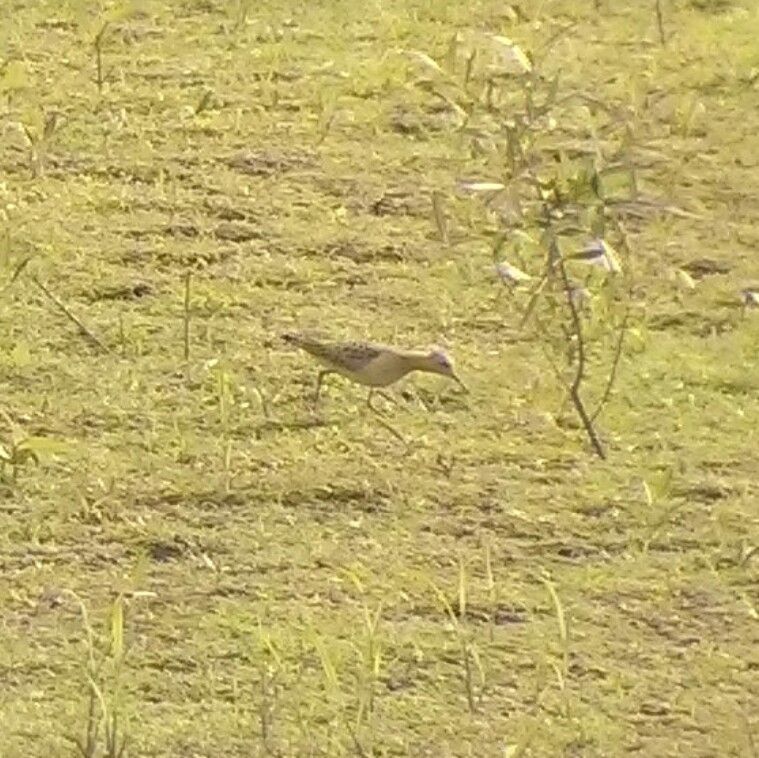famous (to birders) Wilderness Road in Wayne County, OH. The site is famous for being an invaluable piece of stopover habitat for shorebirds headed south for the winter. If you're thinking that Wayne County isn't near the shore, you're correct; "shorebird" is a catch-all term for sandpipers, plovers, dowitchers, phalaropes, godwits, and a host of other birds. A good number of these birds spend a sizable chunk of their time on beaches, and thus, the whole group is given the name "shorebirds."
Wilderness Road is unique for being Ohio's largest mud-puddle. As an Amish peat farm, the ground remains free of vegetation which means that water can form into big wet patches of earth, allowing all kinds of shorebirds a chance to refuel on their epic journeys from one pole to the other. Many different species have shown up here in the past, and this year Ohio birders were lucky to have a group of Buff-breasted Sandpipers use the farm as a rest area. "Buffies" are usually a rare species for Ohio, but this year the numbers have been close to 20 birds at this site alone! I had never seen one of these interesting little birds, so I stopped at Wilderness Road on my way to Cleveland.
I only had about 30 minutes to spend, so I used a spotting scope to count the birds wading in the pools scattered around the peat pit. I turned up Short-billed Dowitchers, Lesser Yellowlegs, and several other species but did not see any Buff-breasted Sandpipers. I did come across a Baird's Sandpiper, a very good bird for Ohio, but no luck was to be had in terms of my target species. However, other birders reported seeing the buffies around the same time I was there. Frustrating to be sure, but I enjoyed a home-cooked meal along with cake and ice cream, so I can't say it was a bad day!
The morning of August 30th I received a text message from Donna, a Columbus-area birder, asking me whether I wanted to make another trip to Wilderness Road. Apparently, a Red-necked Phalarope had been discovered, another species I'd never seen! I met up with Donna and we headed north. In the car, Donna explained the secret to finding buffies: they don't hang out in the water with the other shorebirds. That explained everything, and I have to admit I was a little embarrassed. The good news was that they were still being reported today, so I would have another chance at them.
An hour of driving later, we hopped out of the car amid the loud calls of the Killdeer who are always present in good numbers. All of the usual species were present, and right in their midst was our phalarope!
 |
| The Red-necked Phalarope, my 329th species |
 |
| Phalaropes spend most of their time in the water, spinning in circles while they look for food |
I snapped a few halfway-decent pictures of my newest bird through Donna's spotting scope, and then we looked for Buff-breasted Sandpipers. It was less than a minute of scanning the grassy patches, and I had life bird #330, along with a rather bruised ego. At least now I know to scan the fields though, right? Birding is always a learning experience.
There had been some talk of a Western Sandpiper in the same fields, so we spent some time searching for it. The species is, as it's name suggests, a wanderer from the other side of the continent and another that I've never seen. They're tough to distinguish from the Semipalmated Sandpiper and Least Sandpiper though, and the latter species were present in droves. We picked through the small "peeps," but we didn't see any that stood out to us as a Western. I did get a chance to take some photos though, thanks to some of the birds who showed little fear of me.
 |
| There's one! The elusive Buff-breasted Sandpiper, #330! |
 |
| A Lesser Yellowlegs snapping at the surface of the water and showing off its namesake legs |
 |
| As its name suggests, the Least Sandpiper is our smallest "peep," about the size of a sparrow |
 |
| A young Bald Eagle takes off. These birds don't get their white crown feathers until they're four years old. |
For my full list of birds, you can click here.
No comments:
Post a Comment